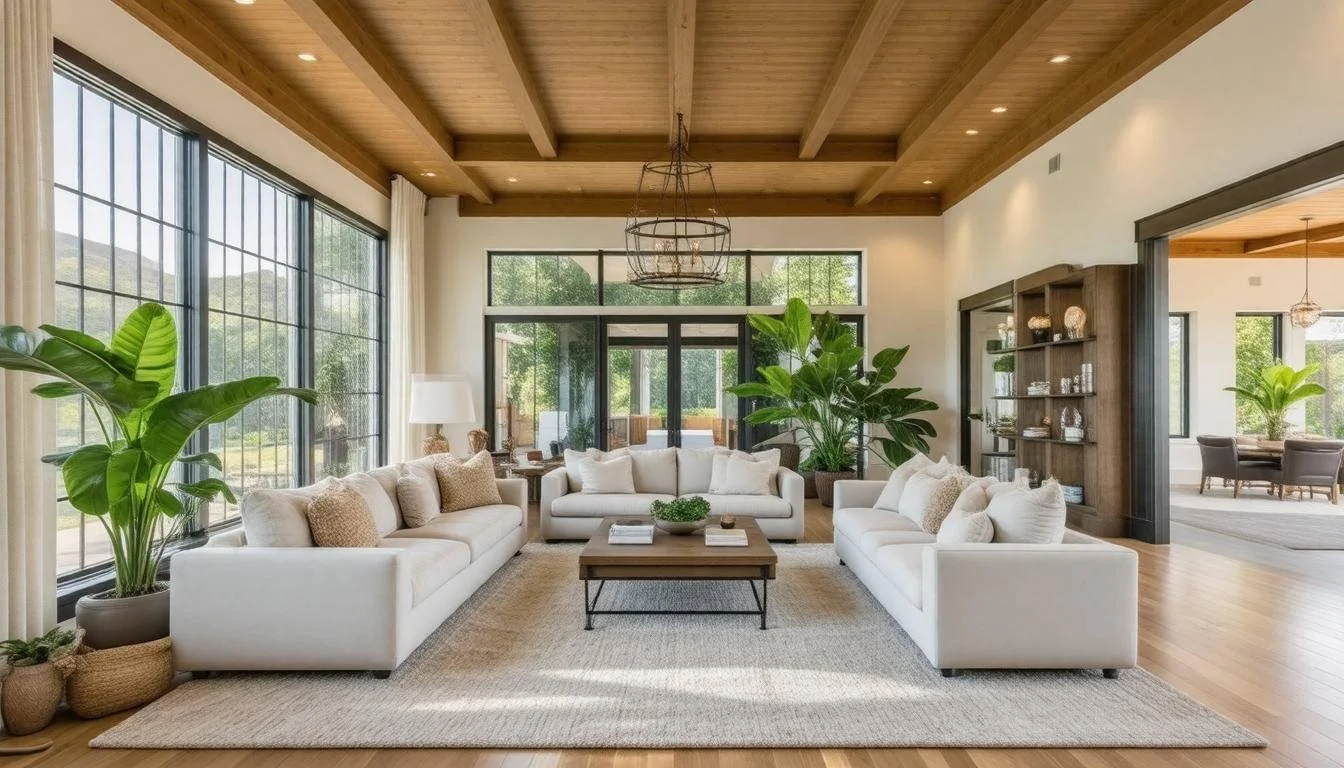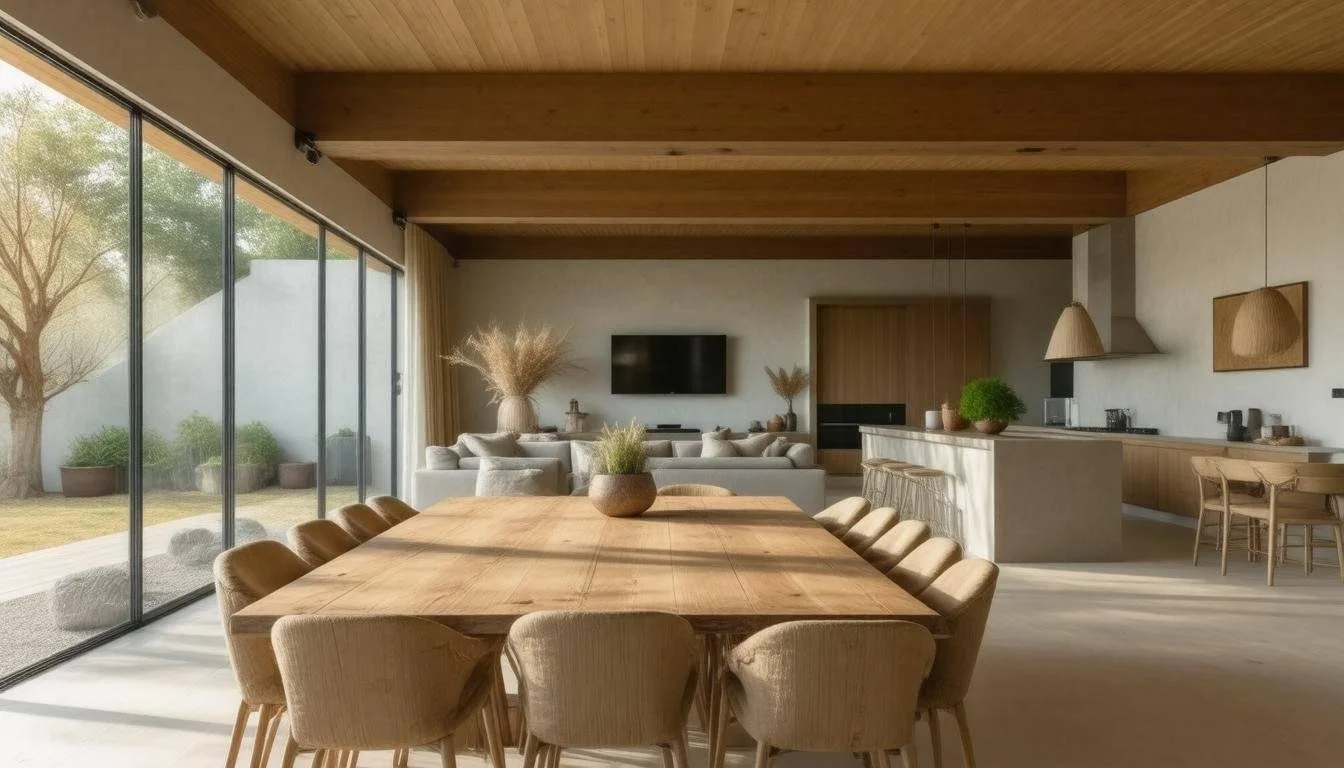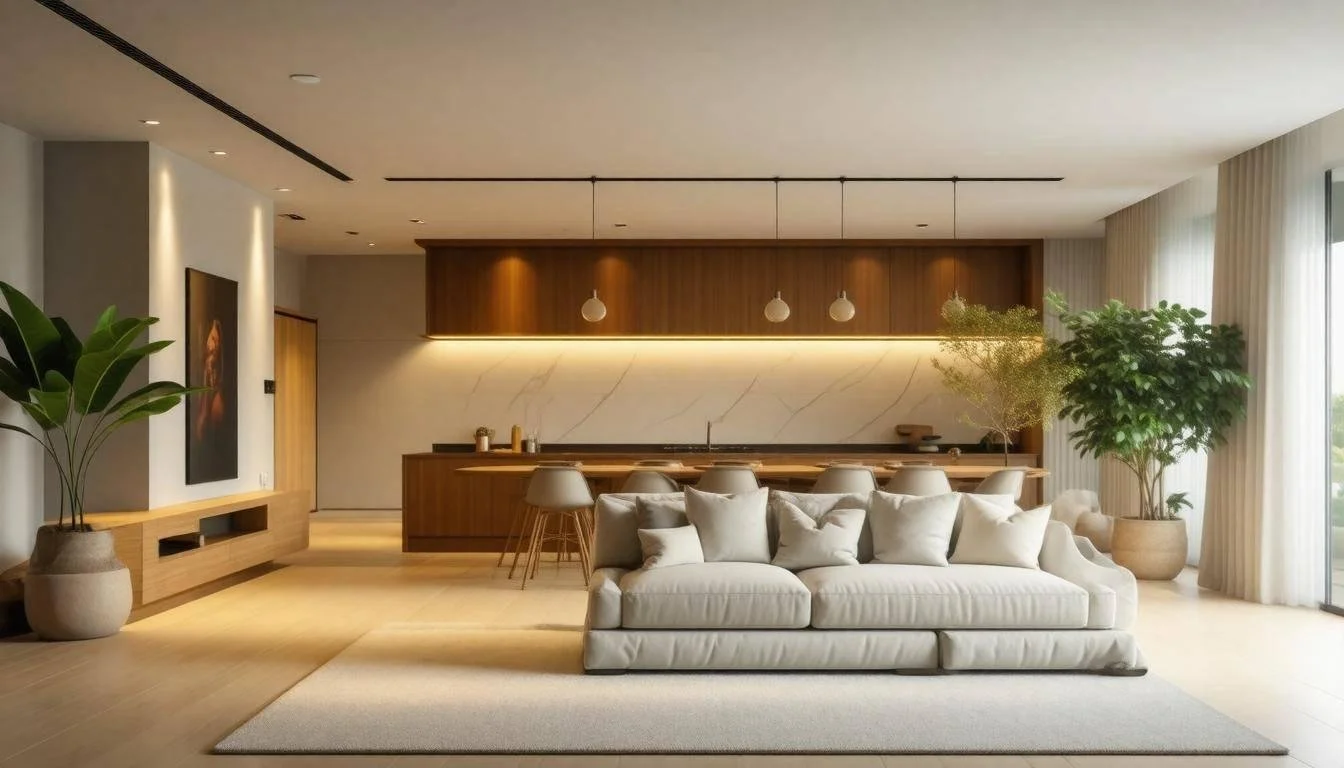How to Create Flow in an Open-Concept Home: Best Design Tips for Harmony
Creating flow in an open-concept home can feel like trying to fit together pieces of a jigsaw puzzle—exciting but sometimes frustrating when things don’t quite match up. If you’ve ever stood at the boundary of your dining room and living area, unsure of how to blend these spaces seamlessly, you’re not alone. Many homeowners face the challenge of crafting a space that feels cohesive while still serving the unique functions of each zone. The beauty of an open layout is its versatility, but finding the right balance takes a little effort and some intentional design choices. Let’s dive into some effective tips that will help you design your open-concept home into a harmonious oasis that invites comfort and connection for everyone who enters.
To create flow in an open-concept home, start by treating the entire area as one cohesive space, selecting a consistent color palette that ties together various zones. Additionally, utilize area rugs and strategically placed furniture to visually define different areas while ensuring that materials and styles echo throughout the space for enhanced harmony.
Assess Your Space and Layout
Start by taking a leisurely stroll through your open areas, paying close attention to how you naturally navigate from one space to another. Are there paths that seem to form without thinking? These are your natural pathways. Identifying these will guide you in placing furniture and decor in ways that feel intuitive rather than obstructive. For instance, if you’ve noticed that you always walk a certain route around the coffee table to get to the kitchen, it’s wise to ensure that nothing blocks that pathway. The flow of movement directly impacts comfort; a house that feels cluttered or cramped can dampen the enjoyment of these beautiful spaces.
Evaluate Natural Pathways
When evaluating natural pathways, consider not only where things move but also how they feel when doing so. A well-defined hallway might guide the eye as much as it aids movement, prompting an elegant transition between spaces. Take note of furniture placement—some pieces may unintentionally create obstacles, while others could serve as functional markers that enhance flow. If onlookers peer around uncomfortable corners or bump into tables, it’s time to rethink their positions to create open access across your zones.
Sketch Your Layout
Don’t worry; you don’t need to be an artist for this stage! Simply grab some graph paper or even doodle on a napkin. Create a simple sketch of your open-concept layout, marking designated areas for different functions—like where you plan to position the kitchen table or the couch. This visual aid helps refine your ideas and creates clarity in planning how each zone interacts with the others. For example, if your kitchen flows directly into the living area but they aren’t clearly defined, use your sketching sessions to refine elements like island placements or seating arrangements.
Incorporating this organized thinking enhances usability and contributes to overall aesthetic unity. Imagine how inviting it will be when guests can effortlessly transition from enjoying dinner to lounging in comfort afterward! Clear pathways combined with distinct zones contribute to both functionality and aesthetic appeal, making the space feel inviting for everyone who steps inside.
The essence of designing effective open spaces lies in understanding flow and functionality, ensuring your home becomes a canvas for both relaxation and interaction.
As we explore further into crafting a cohesive environment, consider how each connected area can complement one another seamlessly. This allows the design narrative of your home to unfold beautifully.
Planning Connected Rooms
Creating connected rooms involves more than merely linking space; it’s about fostering a sense of unity while respecting each area’s purpose. The joy of an open-concept design lies in its flexibility, allowing you to navigate freely from one zone to another. To ensure a smooth transition, you'll want to consider furniture placement, visual identifiers, and the flow of movement within your home.
Functional Zones
Dining Area: Positioning the dining area close to the kitchen is essential for effortless serving, especially during gatherings when dishes are frequently transported. A quick glance from the dining table to the stove should feel natural and stress-free.
Living Area: The living area should occupy a central location within your open space. This arrangement invites interaction and warmth—perfect for family gatherings or entertaining guests. Using furniture arrangements that promote conversation, like facing sofas or chairs, ensures this area remains inviting.
Work Area: If you work from home or pursue hobbies requiring concentration, consider allocating a discrete space for these activities. This area should be low-traffic to minimize distractions while remaining visually cohesive with adjacent spaces. A desk tucked into a corner with a decorative screen can provide privacy without completely separating it from the rest of the home.
The ultimate goal is to create distinct yet intertwined areas that serve their purpose without overwhelming one another. Maintaining visual harmony throughout your home can be achieved by choosing colors and materials that echo one another across these zones.
Think of your open concept as a well-composed symphony: every instrument must contribute without drowning out others, maintaining balance while still creating something beautiful together.
Incorporating rugs can significantly help with defining these spaces further by visually segmenting areas while promoting flow. For instance, placing a vibrant area rug under the dining table can demarcate that zone while complementing textures and colors found in nearby living spaces.
With functional zones established, we can now explore how furniture selections will enhance the seamless integration of these interconnected spaces.
Selecting Furniture for Seamless Spaces
The furniture you choose can significantly influence the overall aesthetic and functionality of an open-concept home. By selecting pieces thoughtfully, you can create a harmonious environment that balances both style and practicality. For instance, opting for multi-functional furniture allows flexibility in design while catering to the needs of various occasions. Modular sofas are an excellent option—these adaptable pieces can be reconfigured to accommodate gatherings or simply everyday relaxation.
Use of Multi-functional Furniture
Choosing multi-functional furniture is not just a smart decision; it's essential for maximizing space in an open layout. Think about pieces like storage ottomans or coffee tables that double as seating or provide hidden compartments for stowing away items. This serves to reduce visual clutter while keeping your living area tidy. Imagine walking into a room where every piece has a purpose—it creates a serene atmosphere rather than one constantly battling against uncomfortable chaos.
A particularly effective approach involves strategically placing a large sectional sofa that can demarcate the living area from the dining room without erecting physical barriers. This way, you maintain an open feeling, yet still provide clear boundaries between different spaces. Functionality can blend with design seamlessly when each piece is chosen with intention, ensuring that comfort reigns supreme amid busy lifestyles.
Additionally, consider natural wood tones for cabinetry and furniture, as these create a timeless feel that draws the eye without overwhelming it. Incorporating bright color accents through throw pillows or smaller decor items adds a cheerful vibration to space while maintaining cohesion through the consistent use of your primary materials. This combination contributes to an inviting look that warms up even the most modern designs.
As you curate your space with intention, keep in mind how clever design choices can enhance both flow and function. This sets the stage for exploring techniques to improve visual continuity within your home.
Visual Tricks to Enhance Flow
Visual cues play a crucial role in enhancing unity and guiding the eyes throughout an open space. For instance, mirrors work wonders not only for checking your appearance but also as delightful tricksters that can transform your environment. By reflecting light, they create an illusion of expanded space, making areas feel more inviting. Imagine placing a mirror opposite a window; that single strategic placement can double the amount of natural light bathing your room. As you walk by, your senses are delighted by the brightness pouring in from both directions.
Mirror Placement
Mirrors can act like windows; they don’t just reflect what's there but also bring in light and depth. Consider positioning mirrors at various heights and angles to catch different light sources, creating visual dynamism while linking spaces. For example, you might have one mirror reflecting the kitchen while another reflects the dining area, subtly connecting these two pivotal spaces.
Utilizing open shelving units is another savvy technique for maintaining sightlines without creating barriers. These shelves offer storage while keeping areas visually connected. However, it’s important to keep them organized—clutter can quickly ruin the effect you’re aiming for. Think about incorporating decorative items or plants on those shelves that echo other elements in the room, tying everything together beautifully.
Another effective trick to enhance flow and create interest is incorporating varying textures throughout your home. While colors set the mood, textures add depth and warmth to a space. Imagine combining sleek metals with soft fabrics and rustic woods; this mix invites touch and a sense of comfort that can transform mere visual appeal into tangible experience.
Using different textures allows you to maintain visual continuity even when working within different zones of your home. A smooth leather chair in one space can harmonize with plush wool throws in another if connected through consistent color schemes.
Besides using mirrors and textures, consider how furniture arrangement affects visual flow without impeding movement through your open space.
Think about defining pathways with clever arrangements; experiment with positioning furniture at angles rather than straight lines. This creates casual nooks that feel cozy and engaged rather than perfectly arranged and sterile. A little creativity here encourages interaction among guests while guiding their eyes naturally across the room.
Emphasizing Lighting Choices
Lastly, don't overlook your lighting. Incorporate different styles of lighting fixtures throughout your open-concept design to draw attention to specific areas. A striking pendant light above a dining table instantly marks that zone while still being visible from other parts of the home, maintaining cohesion without walls.
By leveraging these visual tricks—reflective surfaces, open shelving, varied textures, thoughtful furniture arrangement, and distinct lighting—you create fluidity and charm in your open-concept living spaces that will be a joy for residents and guests alike.
As we move forward, let's explore how choices in colors and materials can further enhance the atmosphere within these interconnected spaces.
Use of Colors and Materials
Consistent colors and materials can tie together various zones in an open-concept home, creating a harmonious flow that invites a sense of serenity into your space. Choosing a cohesive color palette is essential; it not only makes your home look more polished but also establishes a seamless transition between different areas. For instance, if you lean toward earthy tones, consider using rich hues like truffle brown or dusty red. These colors evoke warmth and comfort, making guests feel welcomed as they move from room to room.
It's not just about colors; the choice of materials plays a vital role in achieving visual continuity. Opting for the same type of wood or metal finishes across furniture pieces can create a unified appearance that binds each area together. For example, if your dining table is crafted from warm oak, complement it with chairs or light fixtures that feature similar wood tones or finishes. This approach enhances your design possibilities by ensuring diverse elements feel interconnected.
Textures to Add Depth
Furthermore, textures offer another layer of depth to your design. Combining soft fabrics with hard surfaces can yield a balanced atmosphere that feels inviting yet stylish. Consider incorporating plush cushions or textured throw blankets alongside wooden cabinetry or metal accents. This contrast can elicit both warmth and sophistication—elements indispensable to any successful open-concept design.
Remember that consistency doesn't mean monotony. You can introduce variations within the chosen color palette to maintain interest without disrupting harmony. Shades of eggplant purple, for example, might appear in your living space on accent pillows while dustier shades adorn nearby textiles. Such thoughtful arrangements allow you to express individuality while adhering to the foundational principles of flow.
As you contemplate these aspects of color and material coherence, think about how lighting interacts with these choices—an equally essential element that influences your home's overall ambiance. We now turn our focus toward the impact of effective lighting solutions in maintaining flow throughout your open spaces.
Lighting to Create Movement
Proper lighting techniques are essential for guiding movement and differentiating areas without the confinement of walls. Think of your open-concept space as a wide canvas; how you choose to illuminate it can paint a vivid picture of functionality and style. Layering your lighting effectively allows each area to feel distinct, yet harmoniously connected to the rest of your home. By combining various types of lighting, you can create a dynamic environment that encourages both comfort and practicality.
Layered Lighting
Let's break down the concept of layered lighting into its fundamental components.
Ambient Lighting: This serves as the foundation for your space, providing ample general illumination. It often comes from ceiling fixtures or overhead lights that fill the room with soft, even light. Much like the backdrop in a painting, ambient lighting sets the tone for everything else.
Task Lighting: Essential for functional areas like kitchens or reading nooks, task lighting provides concentrated illumination so you can perform specific activities with ease. Perhaps it’s a pendant light over an island or a sleek desk lamp in the corner; task lighting should cater to each activity zone, enhancing usability without being overwhelming.
Accent Lighting: This type creates drama by highlighting architectural features or artwork. Whether it’s wall sconces flanking your favorite piece of art or spotlights illuminating textured walls, accent lighting draws attention and adds character to your spaces.
Selecting different types of lighting for various zones not only defines spaces but does so in a manner that is visually cohesive. Imagine walking through your home as if navigating through different rooms; while each zone serves a unique purpose, they should still feel like part of one continuous design story.
One effective strategy is to use similar styles or finishes across all light fixtures. For instance, if you've chosen matte black fixtures for ambient lighting, consider matching them with task and accent lights for consistency.
When planning your layout, remember that the brightness and position of your lights can influence how we experience movement throughout the space. An overly bright corner may draw too much attention away from quieter areas, while dimly lit sections might feel cramped and isolated. Aim for a balanced distribution where every layer works together elegantly.
Next time you approach your open-concept layout, take stock of how each lighting aspect interacts with one another. Are there shadows being cast in darker corners that could benefit from additional task or accent lighting? A little upfront analysis can make all the difference in achieving that seamless flow between spaces that you're aiming for.
With an understanding of how lighting contributes to flow, we can now transition to exploring elements like rugs and textures that work hand-in-hand to enhance spatial harmony.
Using Rugs and Textures
An effective way to enhance the harmony in your open spaces is by using rugs to define zones. It’s fascinating how a simple area rug can transform the perception of space. For instance, anchoring a large rug under front of your sofa not only creates a comfortable seating area but also visually separates it from adjoining spaces. This technique helps eliminate the feeling of disconnection between areas that an open floor plan can sometimes bring.
Think of it as drawing invisible lines across the space, guiding the eye and helping guests navigate through different sections without confusion.
Defining Zones with Rugs
When selecting rugs, consider their placement carefully. A luxurious area rug positioned under a table creates an inviting dining zone while distinguishing it from the living room. For example, if you have an 8x10-foot rug under a coffee table, it's like framing a piece of art; it highlights that area as a cozy gathering spot. Remember also to choose rugs that are delightfully soft underfoot, making every step across them feel pleasant.
Furthermore, texture plays a significant role in the overall ambiance of your space. Varying the materials of your rugs and textiles adds delightful contrast while maintaining continuity across zones.
For instance, pairing a plush shag rug in the living room with a flatweave jute rug in the dining area evokes warmth and grounding while introducing both comfort and visual interest. The trick is to ensure that while each texture brings its unique appeal, they still echo each other in tone or material. This strategy successfully fosters connections, creating an effortless transition from one space to another.
Enhancing Continuity Through Texture
To amplify this sense of cohesion, look for ways to reflect those textures in other areas of your decor. If you select a woven jute rug for the dining room, consider adding complementary placemats or decorative baskets made from similar fibers. These subtle nods bind the spaces together.
Thoughtful layering—whether through rugs or textiles—invites depth while ensuring each area feels distinct. It's about crafting narratives within your home through design elements that tell a unified story.
So explore and experiment with materials; perhaps a woven cotton throw on your couch will resonate beautifully with your plain runner on the dining table. As you create these thoughtful tactile relationships, remember they’ll elevate the experience of movement and connection within your open-concept home.
Connecting everything through decor styles is vital; let's explore how to unify your decor.
Unifying Styles in Decor
A consistent design across different areas is essential to creating a harmonious environment that feels both welcoming and thoughtfully curated. When decorating an open-concept home, it's crucial not only to stick to a preferred style but also to ensure that each zone complements the others seamlessly. Imagine walking from your living area into the dining room and feeling like you're gliding through a coherent, beautifully designed narrative—this is the magic that unified decor brings.
Stick to a Singular Design Style
One effective approach is to adopt a specific design style for your entire home. For instance, if you gravitate towards a modern aesthetic, commit to minimalism and sleek lines throughout your space. This doesn't mean sacrificing personality; rather, it allows for personal touches within a broader theme. Think about how colors, materials, and shapes can connect different rooms while allowing individual areas to maintain their unique charm.
The essence of cohesive design lies in creating visual threads that bind one area to another without interrupting the flow.
To illustrate this further, consider how specific design elements can echo throughout your home. If you choose leather sofas in your living area for their sophistication, opt for glass or metal accents in your dining room that mirror those clean lines while introducing a sense of lightness. It's about picking materials that resonate with each other, thus enhancing the overall experience of your open-concept layout.
Additionally, utilizing color effectively can act as powerful glue for various spaces. For instance, if you select warm earth tones for your kitchen cabinetry, carry those hues over into textiles or decorative items in adjacent zones. Such strategic choices make the transition from space to space feel effortless.
Creating Visual Connections with Purposeful Decor
A well-placed table can transform the perception of flow between spaces. When selecting furniture pieces, aim for multifunctional options that serve practical purposes while staying true to your aesthetic. For example, an expandable dining table not only meets your entertaining needs but also enhances the visual connection between the kitchen and dining areas—after all, it’s where meals are prepared and enjoyed.
Ultimately, maintaining cohesive decor throughout your home isn't merely about aesthetics; it has functional implications as well. Unified design fosters an atmosphere that promotes social interaction and relaxation. Each thoughtfully chosen element pieced together creates a tranquil refuge where everything feels in its place—a remarkable achievement especially when transitioning between functional zones.
By weaving together these principles of unified style within key design elements, you'll create an open-concept haven that feels more like a harmonious symphony than disparate notes competing for attention.
In crafting your open-concept masterpiece, remember that every decision influences the overall ambiance—strive for harmony where beauty meets functionality.



